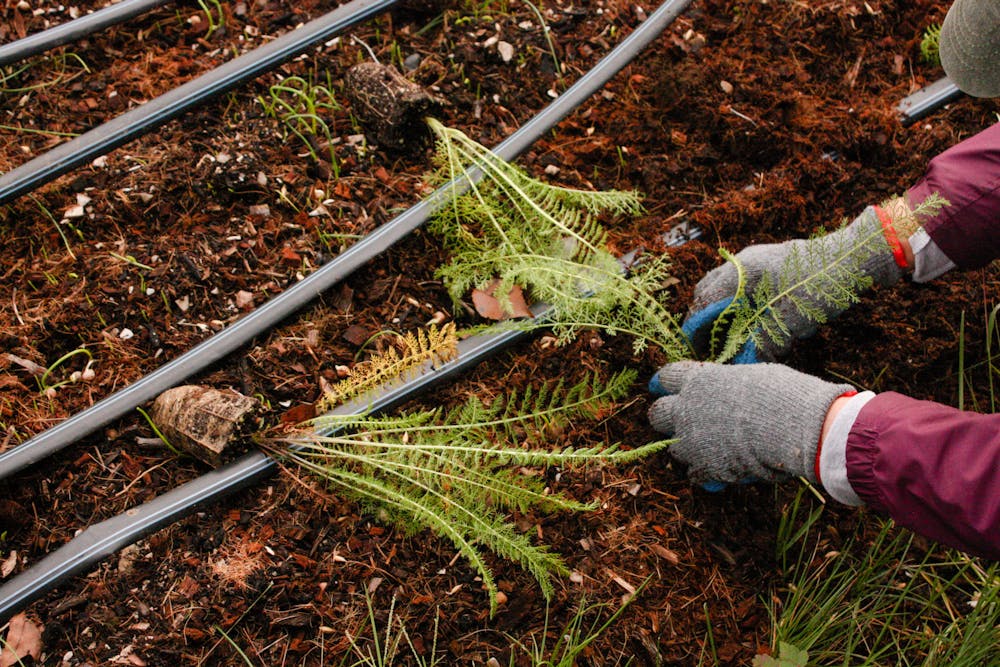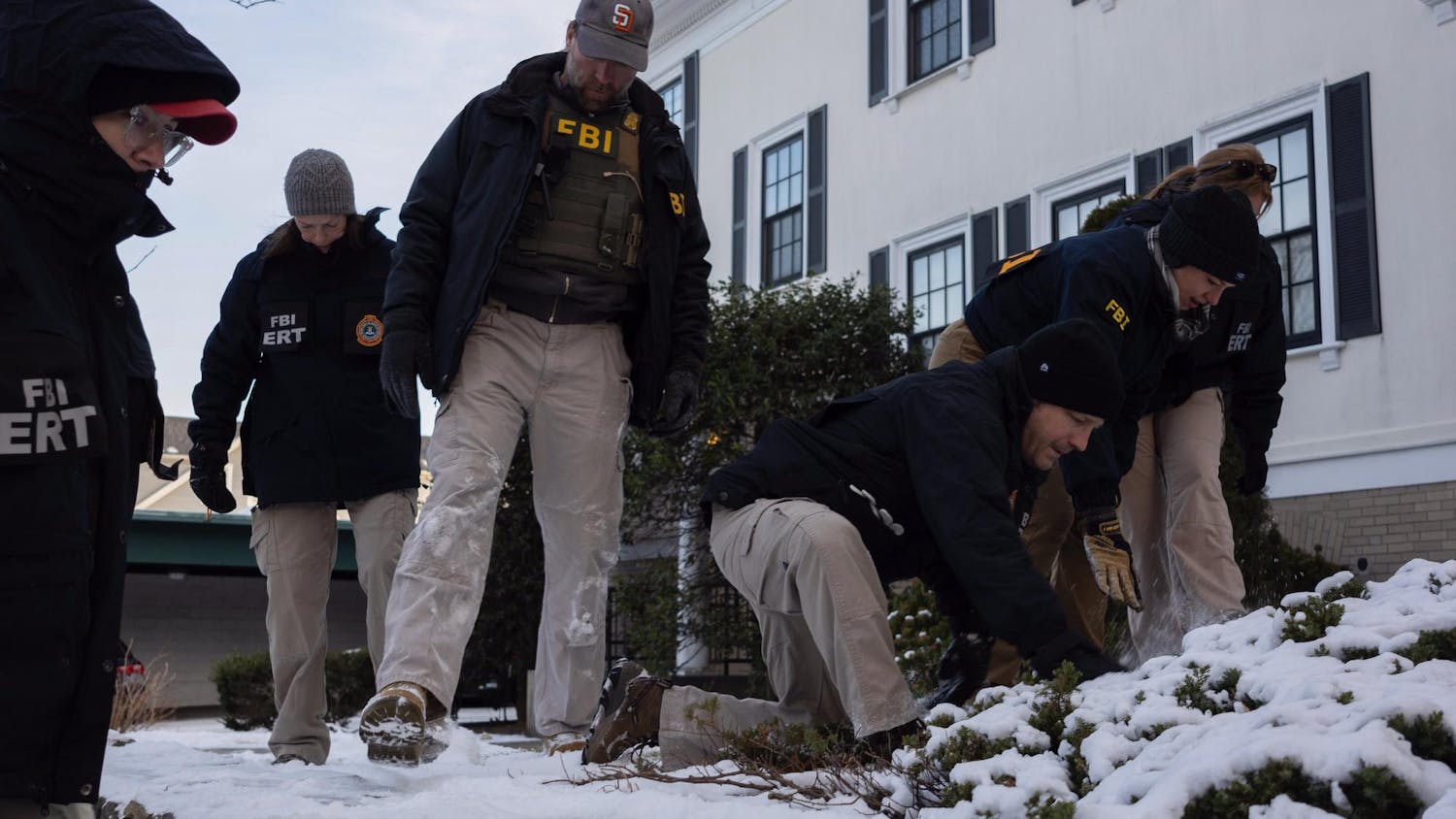Since January, horticulturist Barbara Shaughnessy has been growing 19 native Rhode Island plant species in her South Kingstown backyard. For three days in early winter, volunteers gathered in her wooden shed — clutching their coats and chatting away the cold air — with a peculiar task: to help turn seeds of native plants collected in the wild into healthy plugs.
The whole operation was a delicate process, Shaughnessy said. Beyond trying to ensure the largest number of seeds possible would successfully germinate, it was also important to avoid mixing seeds to achieve desired quotas for each particular species. Each plug tray was clearly labeled in at least three different places, and volunteers worked with one plant species at a time. They ensured the seeds, which were cleaned and refrigerated up until that point, were adequately moist and prepared to “go to bed,” Shaughnessy explained.
As temperatures dropped and the day went on, Shaughnessy and the volunteers placed the trays, now filled with seeds and soil, into wooden boxes to overwinter. There, they stayed for three months, protected from UV rays, mice and other plants. Weekly, Shaughnessy would check on the boxes and ensure her “babies” were cold and growing.
“I work at home,” Shaughnessy said with a giggle.
The once seeds, now germinated and grown into “ready-to-plant” plugs, are finding new homes in farms and land trusts across the state. Shaughnessy’s backyard has turned into a hub for ReSeeding Rhode Island, a project from the Rhode Island Wild Plant Society that hopes to amplify the number of native and ecotypic plants in the state’s supply chain.
Starting big projects from someone’s house is part of RIWPS’s history. According to its website, the society dates back to 1986 when “a congenial group gathered in the cook house at the Audubon Eppley Refuge for a workshop in wild-plant gardening offered by Lisa Gould and Doris Anthony.” Soon, the group was brainstorming ways to bring people together while organizing conservation efforts — “the ground was fertile,” and RIWPS was officially founded in 1987.
The nonprofit has since focused on education, working closely with schools, libraries and college students, as well as working to increase the number of native plants in Rhode Island. Mostly led by volunteers, the organization, like its plants, “grows from the bottom up,” Secretary Mary O’Connor said.
The ReSeeding RI project is part of the society’s new 5-year strategic plan, released in 2022. The plan stresses the need to help expand the presence of native plants.
While the project is new — Botanist Shannon Kingsley ’20, following all the appropriate protocols, collected the first round of wild seeds during the 2022 growing season — it’s already in its distribution phase. The goal, explained RIWPS’s Vice President Dave Vissoe and O’Connor is to create “ecological corridors” — to connect areas of habitat that have been separated by human activity and reestablish natural processes, such as pollination.
The importance of these corridors, O’Connor said, goes beyond plants. “It’s for the sake of biodiversity, the survival of plant species and insect species,” she said.
According to Vissoe, the project functions as a cycle of amplification. As the plugs grow into plants and those give out more seeds, the quantity of native plants available in the supply chain increases continuously. This process, hopefully, he said, would mean that native plants would no longer be isolated — creating “pollinator deserts” — but flourish and connect throughout farms, gardens, parks and more.
Kingsley also highlighted the project’s focus on ecotypic plants: populations of plants that are adapted to a specific environment, according to the RIWPS website. In fact, she added, the ReSeeding RI project was inspired by The Ecotype Project in Connecticut, which focuses on using species to increase climate change resilience, and Rhode Island Natural History Survey’s Rhody Native initiative, which aims to amplify native plants.
Because plant populations evolve and adapt to specific environments, if a particular native plant were to successfully grow in Rhode Island, its seeds would be more likely to survive the state’s environmental conditions than seeds from the same species collected from another state, she explained.
Shannon added that while picking which species would be a part of the project, including goldenrods, bush clovers and cardinal flowers. One of the factors considered was which native plant species were part of the state’s “species of concern.” Pat Foley, president of RIWPS, said that he would like to believe that the project might help remove some species from this category.
“It requires an intervention,” to help “native plants recover from the pressure we put them under,” he said.
Back in her yard, Shaughnessy explained the importance of the project by pointing to how “500 caterpillars are needed to keep one little bird alive.” Vissoe nodded in agreement. “We are overbuilt for living,” he said, but that isn’t true for other life forms. Some, he explained, require very specific conditions — and plant species — to thrive.
Detailing examples of species-specific pollinators, Vissoe points to a mountain mint plug. “Take a whiff of that,” he said as the air filled with freshness. “Farmers are very happy with the product.”

Alby Brandon, owner of Brandon Family Organic Farm — the first farm to be picked to participate in the project — emphasized his contentment with their efforts while heavy rain poured down over West Kingston. Brandon showcased the hundreds of native plants growing at the edge of his field.
When asked about how he first heard about ReSeeding RI, he paused for a second. “Maybe at the farmer’s market?” he said with a laugh.
Brandon is a strong organic farmer, Vissoe said, adding that he was excited to add Brandon to the project.
According to Vissoe, the project also established guidelines for the new seeds that will be acquired from the recently planted plugs. Brandon, for example, will get at least half of the new seeds, while the rest will go back to RIWPS so they can continue distributing plugs to more partners. Brandon said that he would like to explore selling his share of seeds, which he would also grow into plugs at his soon-to-be Garden Center.
Vissoe pointed out that “native plants are sometimes not in sync with the buying cycle” of plant demand, but Shaughnessy ensured “they can change that.”
Brandon, who grows organic tomatoes, strawberries, blackberries and other crops, explained the benefits of native plants to farmers. “If you have more habitat on the farms, you have more beneficial insects and fewer pest problems,” he said, as well as “native pollinators, which are also really good pollinators for vegetables and fruit.”
“Vegetable farming is intensive, (so) we are disturbing the ecology quite a bit,” he explained, pointing to how supporting native plants helps to establish a balance between using and fostering the land.
The next day broke with much more forgiving weather. Over at Revive the Roots, a non-profit organization based in Smithfield, RIWPS’s Seed Starters West — a group of volunteers focused on propagation — arrived carrying colorful tools and ready to plant hundreds of plugs of native yarrow, boneset and swamp milkweed.
With the help of Revive the Roots Farm Manager Annie Bayer, volunteers quickly decided the appropriate distance between plugs, where to place empty trays and how to establish a work rhythm. While they took over the field, Bayer, despite being distracted by “so many plant babies,” explained the history of the nonprofit.
The approximately 23 acres of property are owned by the town of Smithfield but leased to Revive the Roots as they work to steward the land. According to Bayer, the organization was founded 12 years ago “by a bunch of folks that were 19 and 20.” The project was originally to construct a community garden, but, with the incentive of the town, it grew (in)to a larger community space with the goal of “teaching people how to grow alongside nature,” she said.
The property includes a food forest with chickens and ducks, a beekeeping space, a community garden, a composting program and a new pavilion for gathering and hosting events. The organization also produces vegetables for Hope’s Harvest, a hunger relief organization.
Bayer was excited by ReSeeding RI’s effort to work with farmers, since “conservation movements tend to not work alongside farming movements,” she said, explaining how agriculture can cause much damage to land. For her, the project can also help foster “a balance to create a food system that works for us and the environment.”
The benefits of bringing native plants to Revive the Roots are multiple, Bayer explained. The plants can “act as a hedgerow,” she said, stopping wild animals from reaching the crops, and can bring in pollinators that would help with farming. The plants are also “another really beautiful teaching tool,” she said.

According to Shaughnessy, this first year functioned as a trial run for the project and, so far, they are happy with the results. With four years remaining, Shaughnessy believes it’s important to highlight that “the plants really don’t need us, we need them.”
Foley is optimistic about the initiative. “We tend to overstate our ability (as humans) to do good, but I think we are doing good here. We are trying to let nature heal.”

Julia Vaz was the managing editor of newsroom and vice president on The Herald's 134th Editorial Board. Previously, she covered environment and crime & justice as a Metro editor. A concentrator in political science and modern culture and media, she loves watching Twilight (as a comedy) and casually dropping the fact she is from Brazil.





